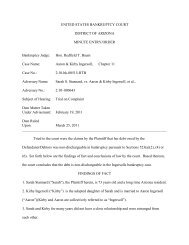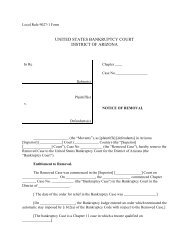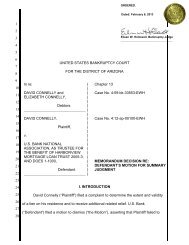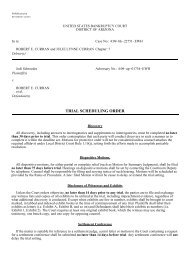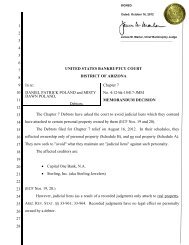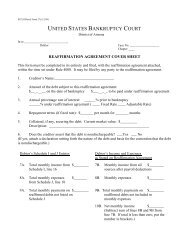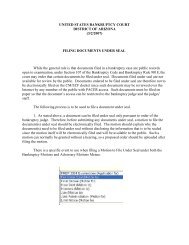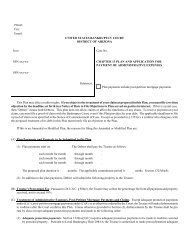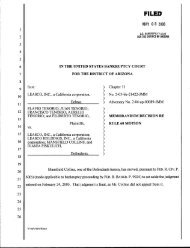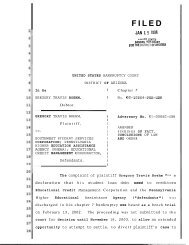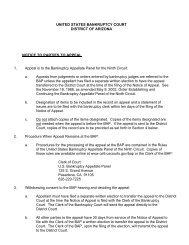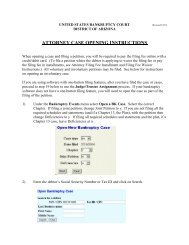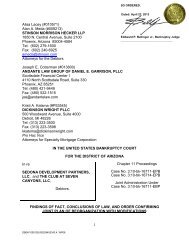1 2 3 4 5 6 7 8 9 10 11 12 13 14 15 16 17 18 19 20 21 22 23 24 25 ...
1 2 3 4 5 6 7 8 9 10 11 12 13 14 15 16 17 18 19 20 21 22 23 24 25 ...
1 2 3 4 5 6 7 8 9 10 11 12 13 14 15 16 17 18 19 20 21 22 23 24 25 ...
You also want an ePaper? Increase the reach of your titles
YUMPU automatically turns print PDFs into web optimized ePapers that Google loves.
1<br />
2<br />
3<br />
4<br />
5<br />
6<br />
7<br />
UNITED STATES BANKRUPTCY COURT<br />
DISTRICT OF ARIZONA<br />
8<br />
9<br />
<strong>10</strong><br />
<strong>11</strong><br />
<strong>12</strong><br />
<strong>13</strong><br />
<strong>14</strong><br />
<strong>15</strong><br />
<strong>16</strong><br />
<strong>17</strong><br />
<strong>18</strong><br />
<strong>19</strong><br />
<strong>20</strong><br />
<strong>21</strong><br />
<strong>22</strong><br />
<strong>23</strong><br />
<strong>24</strong><br />
<strong>25</strong><br />
26<br />
27<br />
28<br />
In Re ) Chapter 7<br />
)<br />
RICHARD JAMES KUDLICKI, SR. ) No. 02-06640-GBN<br />
and MICHELLE KUDLICKI, )<br />
)<br />
Debtors. )<br />
________________________________)<br />
)<br />
J.E. SCHELLER PLUMBING, INC., ) Adversary No. 02-00893<br />
D/B/A JOEL’S QUALITY POOL & )<br />
SPA PLUMBING, )<br />
)<br />
Plaintiff, )<br />
) FINDINGS OF FACT,<br />
vs. ) CONCLUSIONS OF LAW<br />
) AND INTERIM ORDER<br />
RICHARD JAMES KUDLICKI, SR. )<br />
and MICHELLE KUDLICKI, )<br />
)<br />
Defendants. )<br />
________________________________)<br />
The adversary complaint of J.E. Scheller Plumbing,<br />
Inc., d/b/a Joel’s Quality Pool and Spa Plumbing (“Plaintiff”)<br />
seeking a declaration of nondischargeability of its bankruptcy<br />
claim against Michelle Kudlicki and her marital community<br />
property interest (“Defendant” or “Debtor”) was tried to this<br />
court as a bench trial on November 5 and December 9, <strong>20</strong>04. Post<br />
trial briefing was completed on December <strong>23</strong>, <strong>20</strong>04. An interim<br />
order was entered on January <strong>14</strong>, <strong>20</strong>05 announcing the court’s<br />
decision.
1<br />
2<br />
3<br />
4<br />
5<br />
6<br />
7<br />
8<br />
9<br />
<strong>10</strong><br />
<strong>11</strong><br />
<strong>12</strong><br />
<strong>13</strong><br />
<strong>14</strong><br />
<strong>15</strong><br />
<strong>16</strong><br />
<strong>17</strong><br />
<strong>18</strong><br />
<strong>19</strong><br />
<strong>20</strong><br />
<strong>21</strong><br />
The court has considered sworn witness testimony,<br />
admitted exhibits and the facts and circumstances of this case.<br />
The following findings and conclusions are now entered:<br />
FINDINGS OF FACT<br />
1. Debtor and her co-debtor husband, Richard James<br />
Kudlicki, Sr., (“Defendants”) scheduled an unsecured claim held<br />
by Joel’s Quality Pool and Spa Plumbing of $<strong>19</strong>,035.<strong>10</strong> in their<br />
personal Chapter 7 bankruptcy case filed May 2, <strong>20</strong>02. Schedule F<br />
at p. 8. The Kudlickis’ sworn schedules indicated this claim was<br />
not contingent, unliquidated or disputed. Id. at p. 1.<br />
Plaintiff’s complaint, seeking a determination of<br />
nondischargeability of its debt was timely filed against both<br />
debtors on August <strong>13</strong>, <strong>20</strong>02.<br />
2. On August 1, <strong>20</strong>03, the court granted plaintiff’s<br />
motion for partial summary judgment against the defendant<br />
husband, ruling that plaintiff’s debt was nondischargeable 1 .<br />
Minutes of August 1, <strong>20</strong>03, adversary docket entry (“dkt”) 27. At<br />
the same hearing, the court denied plaintiff’s motion as to<br />
debtor, finding a dispute of material facts. Id. Plaintiff’s<br />
renewed motion for summary judgment of January <strong>16</strong>, <strong>20</strong>04 was<br />
denied on April 9, <strong>20</strong>04. The court ruled that an evidentiary<br />
<strong>22</strong><br />
<strong>23</strong><br />
<strong>24</strong><br />
<strong>25</strong><br />
26<br />
27<br />
28<br />
1The court ruled that funds received from customers for pool<br />
work, held in trust for subcontractors, was not paid to them but<br />
instead was used as working capital. Mr. Kudlicki, as president<br />
and an owner of Canyon, with the power to direct how funds were<br />
allocated, was declared liable under <strong>11</strong> U.S.C. §5<strong>23</strong>(a)(4). Oral<br />
ruling of August 1, <strong>20</strong>03.<br />
2
1<br />
2<br />
3<br />
4<br />
5<br />
6<br />
7<br />
8<br />
9<br />
<strong>10</strong><br />
<strong>11</strong><br />
<strong>12</strong><br />
<strong>13</strong><br />
<strong>14</strong><br />
<strong>15</strong><br />
<strong>16</strong><br />
<strong>17</strong><br />
<strong>18</strong><br />
<strong>19</strong><br />
<strong>20</strong><br />
<strong>21</strong><br />
<strong>22</strong><br />
<strong>23</strong><br />
<strong>24</strong><br />
<strong>25</strong><br />
26<br />
27<br />
28<br />
hearing was required to determine the liability of debtor and her<br />
community property interest. Dkt. 47.<br />
3. Debtor and her husband were the only owners and<br />
officers of Canyon State Pools, Inc. Debtor was also a full time<br />
Canyon employee, responsible for scheduling pool construction<br />
work by subcontractors, such as plaintiff. This employment was<br />
her primary income source. She would maintain a flow chart,<br />
reflecting each pool project, owner, contract amount and<br />
construction status. Debtor would monitor the status, contact<br />
subcontractors and schedule their work as the project progressed.<br />
Plaintiff’s office manager would usually ask for debtor to<br />
discuss jobs or payment, as she was considered their contact<br />
person. It was vital for debtor, as scheduler, to know which<br />
subcontractors were paid, so she would know who could be called<br />
upon to subsequently work on a project. She would pay some<br />
construction bills, which the company accountant would later<br />
allocate to a particular project. She spoke to subcontractors<br />
daily and knew that a number were unpaid. This had been occurring<br />
for some time. She had access to the company checkbook, was a<br />
signatory on the business account and would have the authority<br />
and ability to access paper and computerized company financial<br />
records 2 .<br />
2Debtor’s testimony regarding her actual ability to use the<br />
“Quick Book” program to access Canyon computerized records was<br />
confused. Mr. Kudlicki testified debtor received “some” training<br />
on Quick Books from him. Debtor’s denial on direct that she could<br />
use Quick Books was impeached. On cross, she again appeared to<br />
assert she could not use the product. Whether she actually<br />
(continued...)<br />
3
1<br />
2<br />
3<br />
4<br />
5<br />
6<br />
7<br />
8<br />
9<br />
<strong>10</strong><br />
<strong>11</strong><br />
<strong>12</strong><br />
<strong>13</strong><br />
<strong>14</strong><br />
<strong>15</strong><br />
<strong>16</strong><br />
<strong>17</strong><br />
<strong>18</strong><br />
<strong>19</strong><br />
<strong>20</strong><br />
<strong>21</strong><br />
<strong>22</strong><br />
<strong>23</strong><br />
Debtor would deposit checks into the company banking account.<br />
Her salary was $ 2,<strong>20</strong>0 monthly. Her husband was paid<br />
$ 4,000 net monthly. The Kudlickis received their full salary and<br />
would also pay their employees, even when subcontractors were<br />
unpaid. They also took salary and paid employees when state sales<br />
taxes were delinquent. The Kudlickis did not miss a paycheck<br />
until they closed Canyon on November <strong>12</strong>, <strong>20</strong>01. They would also<br />
take personal loans from Canyon at <strong>10</strong>% interest. Sometimes the<br />
loans would be repaid and sometimes not. Canyon’s business<br />
declined in July and August of <strong>20</strong>01, when pool sales dropped by<br />
one-half. Debtor was impeached a number of times during her trial<br />
testimony with her prior deposition testimony. Testimony<br />
(“test.”) of Michael J. Szobosan, Test. of Michelle Kudlicki,<br />
Test. of Stacy Scheller, Test. of Daniel M. Merjil, Test. of<br />
Janine Vance, Admitted exhibit (“Ex.”) 6 at p. 3 (reflecting a<br />
Department of Revenue levy of $48,9<strong>23</strong>.34 on August 29, <strong>20</strong>01), Ex.<br />
3 (Payroll checks for Richard and Michelle Kudlicki, June-August<br />
<strong>20</strong>01), Ex. 31 (Company checks signed by debtor), Ex. <strong>14</strong> at<br />
admission 9, p.<strong>10</strong>.<br />
4. Debtor would contact pool owners for payment and<br />
would talk to subcontractors about payment issues. She would be<br />
the person to receive complaints from subcontractors about not<br />
being paid. However, her husband, who was always Canyon’s<br />
<strong>24</strong><br />
president, made the decisions regarding<br />
which subcontractors<br />
<strong>25</strong><br />
26<br />
27<br />
28<br />
2(...continued)<br />
accessed computerized records is unimportant. See legal<br />
conclusion 5.<br />
4
1<br />
2<br />
3<br />
4<br />
5<br />
6<br />
7<br />
would be paid and when. She did not exercise independent payment<br />
judgment. The company had unpaid subcontractors in July of <strong>20</strong>01,<br />
but continued to operate and pay salaries, until the business<br />
closed in November of <strong>20</strong>01.<br />
During July of <strong>20</strong>01, the Kudlickis made $350 per month<br />
payments on a 26' boat they earlier purchased and bought<br />
$3,699.99 in new bedroom furniture for a $4<strong>25</strong>,000 Chandler,<br />
8<br />
Arizona home nearing completion.<br />
Debtor signed a number of<br />
9<br />
<strong>10</strong><br />
<strong>11</strong><br />
<strong>12</strong><br />
<strong>13</strong><br />
<strong>14</strong><br />
<strong>15</strong><br />
<strong>16</strong><br />
<strong>17</strong><br />
<strong>18</strong><br />
<strong>19</strong><br />
<strong>20</strong><br />
<strong>21</strong><br />
<strong>22</strong><br />
<strong>23</strong><br />
<strong>24</strong><br />
personal checks for additional home furniture, including<br />
$7,360.65 and $2,084.52 to furniture vendors and $ 6,054.31 for<br />
appliances on July <strong>11</strong>, <strong>20</strong>01. Ms. Diana Glynn in deposition<br />
testimony 3 , characterized defendants’ behavior as “spending money<br />
right and left” at this time, including acquiring “... (a) whole<br />
house full of furniture” and “breast augmentation surgery.”<br />
Debtor and her husband deeded the Chandler home back to mortgagee<br />
First Arizona Mortgage and left the residence in mid November of<br />
<strong>20</strong>01. They did receive and retain $8,000 cash for a television<br />
left at the residence.<br />
Mr. Kudlicki had no employment or income other than<br />
from Canyon Pools. Defendants’ response to plaintiff’s second<br />
request to produce contains no documents establishing that Scott<br />
Glynn of the Lariat Group, LLC, builder of the Chandler<br />
residence, provided money for to defendants that was not Canyon<br />
revenue. Defendants’ answers to plaintiff’s second set of<br />
<strong>25</strong><br />
26<br />
27<br />
28<br />
3The Glynn depositions were admitted without objection on<br />
December 9, <strong>20</strong>04. Ex.<strong>19</strong>.<br />
5
1<br />
2<br />
3<br />
4<br />
5<br />
6<br />
7<br />
8<br />
9<br />
<strong>10</strong><br />
<strong>11</strong><br />
<strong>12</strong><br />
<strong>13</strong><br />
<strong>14</strong><br />
<strong>15</strong><br />
<strong>16</strong><br />
<strong>17</strong><br />
<strong>18</strong><br />
<strong>19</strong><br />
<strong>20</strong><br />
<strong>21</strong><br />
<strong>22</strong><br />
<strong>23</strong><br />
<strong>24</strong><br />
<strong>25</strong><br />
26<br />
interrogatories stated the furniture, appliances and home<br />
furnishing purchases were funded in part from personal<br />
construction draws on the Chandler home. However, the documents<br />
defendants produced to establish this assertion do not support<br />
their testimony. Homebuilder Scott Glynn’s deposition testimony<br />
is that Canyon State Pools was the Lariat Group’s swimming pool<br />
subcontractor and built the pool at the Chandler residence.<br />
Ultimately Defendants purchased the home. Mr. Glynn produced<br />
copies of Lariat checks representing July of <strong>20</strong>01 payments of<br />
$9,300 and $6,000 for pool and fence landscaping work done by<br />
Canyon, but made payable to Mr. Kudlicki. Subcontractor’s lien<br />
releases were signed by Mr. Kudlicki on behalf of Canyon State<br />
Pools. Although denying that the funds expended for personal<br />
expenses came from payments made to Canyon, Mr. Kudlicki cannot<br />
explain why he signed subcontractor lien releases for Lariat on<br />
behalf of Canyon. It is clear to this fact finder that Canyon<br />
constructed the pool at the Chandler residence. Debtor even<br />
recalls being the scheduler for that job. The September <strong>24</strong>, <strong>20</strong>01<br />
settlement statement for the Kudlicki $366,000 mortgage note for<br />
the home does not contain a line item allocation providing<br />
funding for furniture or appliance purchases.<br />
Mr. Kudlicki does not exactly know the source of<br />
funding for the July furniture and appliance purchases. On crossexamination<br />
he suggested funding could be from yard sales, for<br />
which he has no receipts. He could not recall if the Lariat<br />
checks were used as well. On redirect examination he testified<br />
27<br />
28 6
1<br />
2<br />
3<br />
4<br />
5<br />
6<br />
7<br />
8<br />
9<br />
<strong>10</strong><br />
<strong>11</strong><br />
only one yard sale was conducted, although additional asset sales<br />
were made to friends over time. This information was not<br />
previously provided in defendants’ responses to plaintiff’s<br />
discovery requests. He denied the Lariat checks were payments to<br />
Canyon, although he signed lien waivers on Canyon’s behalf.<br />
Canyon had a half dozen unpaid subcontractors in July of <strong>20</strong>01. In<br />
response to questions from the court, he testified money for<br />
household furnishings also came from personal savings. Up to<br />
$<strong>10</strong>,000 of the savings were kept at home in a gun safe, rather<br />
than in the couple’s banking accounts. This particular<br />
explanation was not provided in defendants’ pretrial discovery<br />
<strong>12</strong><br />
responses.<br />
Debtor testified the monies used for her July<br />
<strong>13</strong><br />
<strong>14</strong><br />
<strong>15</strong><br />
<strong>16</strong><br />
<strong>17</strong><br />
<strong>18</strong><br />
<strong>19</strong><br />
<strong>20</strong><br />
<strong>21</strong><br />
<strong>22</strong><br />
<strong>23</strong><br />
<strong>24</strong><br />
<strong>25</strong><br />
26<br />
cosmetic surgery came from her personal savings. No documentary<br />
evidence of such savings was presented. Debtor has no idea where<br />
the money for the spending on the house came from, how much money<br />
was raised from a yard sale or how much money was put into the<br />
house by the couple. The fact finder does not find defendants’<br />
testimony regarding the source of funds for personal expenditures<br />
to be credible.<br />
This fact finder further determines that defendants’<br />
testimony that no money derived from Canyon State Pool operations<br />
was used to pay personal expenses during the time subcontractors<br />
were going unpaid is not credible. The Court finds that the<br />
source of funding for defendants’ personal spending was their<br />
community interest in the revenue from Canyon State Pools.<br />
Szobosan test., Debtor test., Test. of Richard James Kudlicki,<br />
27<br />
28 7
1<br />
2<br />
3<br />
4<br />
5<br />
6<br />
7<br />
8<br />
9<br />
<strong>10</strong><br />
<strong>11</strong><br />
<strong>12</strong><br />
<strong>13</strong><br />
<strong>14</strong><br />
<strong>15</strong><br />
<strong>16</strong><br />
<strong>17</strong><br />
<strong>18</strong><br />
<strong>19</strong><br />
<strong>20</strong><br />
<strong>21</strong><br />
<strong>22</strong><br />
<strong>23</strong><br />
<strong>24</strong><br />
<strong>25</strong><br />
26<br />
Sr., Ex. <strong>12</strong>, Ex. <strong>17</strong> at construction project agreement, p.2, Ex.<br />
4, Ex. <strong>16</strong> at p.3, Ex. <strong>15</strong> at pgs. 1-4, Ex. <strong>17</strong>, Ex. <strong>19</strong> at pgs. <strong>12</strong>-<br />
<strong>15</strong> and <strong>22</strong>-<strong>24</strong> of deposition of Diana Glynn. Also, see Ex. <strong>19</strong> at<br />
Pgs.5-<strong>15</strong>, 26, 30-31, 33 and exhibits for Scott Glynn deposition.<br />
5. On August <strong>24</strong>, <strong>20</strong>01, a month after spending at least<br />
$<strong>25</strong>,000 on the new Chandler home, Richard Kudlicki sent a letter<br />
on Canyon State letterhead to plaintiff and other unpaid<br />
subcontractors. He indicated a lack of working capital meant<br />
“...we have in effect ‘borrowed’ the operating capital from our<br />
partner businesses, such as yours...” and requested patience as<br />
“Michelle and I have retained the services of a management<br />
consultant...” Debtor “supposes” she saw this letter before it<br />
went out. She recalls sitting in on some of the meetings with the<br />
management consultant. Debtor test., Ex. 32.<br />
6. To the extent any of the following conclusions of<br />
law should be considered findings of fact, they are hereby<br />
incorporated by reference.<br />
CONCLUSIONS OF LAW<br />
1. To the extent any of the above findings of fact<br />
should be considered conclusions of law, they are hereby<br />
incorporated by reference.<br />
2. Jurisdiction of defendants’ bankruptcy case is<br />
vested in the United States District Court for the District of<br />
Arizona. 28 U.S.C. §<strong>13</strong>34(a) (<strong>19</strong>94). That court has referred all<br />
cases under Title <strong>11</strong> of the United States Code and all adversary<br />
proceedings and contested matters arising under Title <strong>11</strong> or<br />
27<br />
28 8
1<br />
2<br />
3<br />
4<br />
5<br />
6<br />
7<br />
8<br />
9<br />
<strong>10</strong><br />
<strong>11</strong><br />
<strong>12</strong><br />
<strong>13</strong><br />
<strong>14</strong><br />
<strong>15</strong><br />
<strong>16</strong><br />
<strong>17</strong><br />
<strong>18</strong><br />
<strong>19</strong><br />
<strong>20</strong><br />
<strong>21</strong><br />
<strong>22</strong><br />
<strong>23</strong><br />
<strong>24</strong><br />
<strong>25</strong><br />
26<br />
related to a bankruptcy case to the United States Bankruptcy<br />
Court for the District of Arizona. 28 U.S.C. §<strong>15</strong>7(a) (<strong>19</strong>94),<br />
Amended District Court General Order 01-<strong>15</strong>. This adversary<br />
proceeding having been appropriately referred, this court has<br />
core bankruptcy jurisdiction to enter a final order determining<br />
the dischargeability of plaintiff’s claim. 28 U.S.C.<br />
§<strong>15</strong>7(b)(2)(I).<br />
3. This court’s conclusions of law are review de novo<br />
and its factual findings are reviewed for clear error. Rule 80<strong>13</strong><br />
F.R.Br.P., Hanf v. Summers (In re Summers), 332 F.3d. <strong>12</strong>40, <strong>12</strong>42<br />
(9 th Cir. <strong>20</strong>03). The appellate court accepts the bankruptcy<br />
court’s findings, unless upon review, it is left with the<br />
definite and firm conviction that a mistake has been committed.<br />
Ganis Credit Corp. v. Anderson (In re Jan Weilert RV, Inc.), 3<strong>15</strong><br />
F.3d <strong>11</strong>92, <strong>11</strong>96 (9 th Cir.) amended by 326 F.3d <strong>10</strong>28 (9 th Cir.<br />
<strong>20</strong>03).<br />
4. This court previously determined that the husband’s<br />
failure as president and an owner of Canyon to ensure that<br />
subcontractors were paid from proceeds received from residential<br />
pool construction contracts resulted in nondischargeability of<br />
plaintiff’s claim as to him personally and his marital community<br />
property interest. Fn. 1, supra. Mindful that a court must be<br />
careful in analysis of a spouse’s liability, as assumption of<br />
business functions by a spouse may not carry the weight that such<br />
conduct on the part of a stranger would imply, this court<br />
required an evidentiary hearing. The purpose was to determine the<br />
27<br />
28 9
1<br />
2<br />
3<br />
4<br />
5<br />
6<br />
7<br />
8<br />
9<br />
<strong>10</strong><br />
<strong>11</strong><br />
<strong>12</strong><br />
<strong>13</strong><br />
<strong>14</strong><br />
<strong>15</strong><br />
<strong>16</strong><br />
<strong>17</strong><br />
<strong>18</strong><br />
<strong>19</strong><br />
<strong>20</strong><br />
<strong>21</strong><br />
<strong>22</strong><br />
<strong>23</strong><br />
<strong>24</strong><br />
<strong>25</strong><br />
26<br />
precise nature of debtor’s relationship and activities in Canyon<br />
and the source of funds for household expenses during the time<br />
plaintiff was unpaid. See, Tsurukawa v. Nikon Precision, Inc. (In<br />
re Tsurukawa), 287 B.R. 5<strong>15</strong>, 5<strong>22</strong> (Bankr. 9 th Cir. <strong>20</strong>02)<br />
(“Tsurukawa II”). The relationship, activities and source of<br />
funds are now clear.<br />
5. Debtor’s marital status alone does not create an<br />
agency relationship sufficient to attribute her husband’s<br />
wrongful conduct to her for §5<strong>23</strong>(a) liability purposes. Tsurukawa<br />
v. Nikon Precision, Inc. (In re Tsurukawa), <strong>25</strong>8 B.R. <strong>19</strong>2, <strong>19</strong>8<br />
(Bankr. 9 th Cir. <strong>20</strong>01). A debt may be excepted from discharge<br />
either when (1) debtor personally commits the act creating nondischargeability<br />
or (2) the wrongdoing of another is imposed on<br />
debtor through agency or partnership principles. Tsurukawa II at<br />
5<strong>25</strong>. Where there are no facts showing individual culpability on<br />
the part of an “innocent” spouse, liability can still be imputed<br />
under partnership or agency principles, if debtor is the business<br />
partner of the culpable spouse. Id. at 527. Further, the<br />
“innocent” spouse’s knowledge of the culpable spouse’s conduct<br />
can be relevant, depending on the circumstances, to infer<br />
culpable intent on her part. Taylor Freezer Sales of Arizona,<br />
Inc. v. Oliphant (In re Oliphant), 2<strong>21</strong> B.R. 506, 5<strong>11</strong> (Bankr. D.<br />
Az. <strong>19</strong>98).<br />
Debtor was an actual, functioning full business<br />
partner of her husband, well aware of the developing crisis<br />
involving unpaid subcontractors and large contemporaneous<br />
27<br />
28 <strong>10</strong>
1<br />
2<br />
3<br />
4<br />
5<br />
6<br />
7<br />
8<br />
9<br />
<strong>10</strong><br />
<strong>11</strong><br />
<strong>12</strong><br />
<strong>13</strong><br />
<strong>14</strong><br />
<strong>15</strong><br />
<strong>16</strong><br />
<strong>17</strong><br />
<strong>18</strong><br />
<strong>19</strong><br />
<strong>20</strong><br />
<strong>21</strong><br />
<strong>22</strong><br />
<strong>23</strong><br />
<strong>24</strong><br />
expenditures for marital household purposes. She did not merely<br />
hold a “paper title” as an officer of Canyon. Debtor had<br />
authority and ability to access company books and records.<br />
Whether and how often she actually exercised this authority is<br />
unclear, but unimportant. Insofar as the events precipitating<br />
the company’s crisis are concerned, she knew what was happening,<br />
as it happened, where money was going and where it wasn’t going.<br />
She worked full time as the company scheduler, dealing<br />
daily with subcontractors and by her own admission, well aware<br />
of whom had not been paid. Debtor was also well aware of large<br />
personal expenditures for the new Chandler home at the same time.<br />
Indeed, she was the signatory on many of the personal checks<br />
issued in payment. In August of <strong>20</strong>01, when the company admitted<br />
in writing that funds entrusted for subcontractor payments were<br />
diverted for working capital, 4 debtor was specifically listed as<br />
involved in the effort to deal with the situation. She made no<br />
objection to being expressly included in this public<br />
communication and participated in some of the subsequent<br />
consulting meetings . More importantly, there is no indication<br />
she objected to or resisted her husband’s practice of not<br />
compensating all subcontractors. Debtor was apparently content<br />
with allowing her husband to make these payment decisions. Her<br />
acquiescence to his decisions in this particular area does not<br />
mean she was not a married business partner. See Tsurukawa II at<br />
<strong>25</strong><br />
26<br />
27<br />
28<br />
4Uses of working capital included payment of full salaries<br />
to debtor and her spouse.<br />
<strong>11</strong>
1<br />
2<br />
3<br />
4<br />
5<br />
6<br />
7<br />
8<br />
5<strong>22</strong>. As a signatory on the company banking account, who actually<br />
wrote company checks, she could have made payment to<br />
subcontractors, such as plaintiff. She instead chose to write<br />
personal checks for household furnishings.<br />
The court concludes plaintiff’s claim against debtor<br />
is nondischargeable under Tsurukawa II on both an agency theory,<br />
as a marital business partner and on her own personal conduct. As<br />
an active officer and co owner of the business, she tolerated,<br />
9<br />
ratified<br />
and participated in her husband’s improper use of<br />
<strong>10</strong><br />
<strong>11</strong><br />
<strong>12</strong><br />
<strong>13</strong><br />
<strong>14</strong><br />
<strong>15</strong><br />
<strong>16</strong><br />
<strong>17</strong><br />
<strong>18</strong><br />
<strong>19</strong><br />
<strong>20</strong><br />
<strong>21</strong><br />
<strong>22</strong><br />
<strong>23</strong><br />
<strong>24</strong><br />
<strong>25</strong><br />
26<br />
27<br />
28<br />
subcontractor trust funds in violation of <strong>11</strong> U.S.C. § 5<strong>23</strong>(a)(4).<br />
6. Community property is not liable for a debt unless<br />
it is shown to be a community claim. Case v. Maready (In re<br />
Maready), <strong>12</strong>2 B.R. 378, 381 (Bankr. 9 th Cir. <strong>19</strong>91). A marital<br />
community whose actions do not conform to the standards imposed<br />
by law should not earn the discharge received by joint debtors<br />
who did not engage in the proscribed conduct. Valley National<br />
Bank v. LeSueur (In re LeSueur), 53 B.R. 4<strong>14</strong>, 4<strong>16</strong> (Bankr. D.Az.<br />
<strong>19</strong>85). This is such a community. In this case the court has<br />
concluded there is no “innocent spouse.” Accordingly the tests<br />
established for liability of the community based on the acts of<br />
only one spouse are inapplicable. See F.D.I.C. v. Soderling (In<br />
re Soderling), 998 F. 2d 730, 733 (9 th Cir. <strong>19</strong>93). 5 The court<br />
5Even assuming debtor had been an “innocent” spouse, her<br />
husband’s tortious acts committed with the intent of benefiting<br />
the community by keeping the family pool business operating,<br />
would still impose liability on the marital community, regardless<br />
of whether the community actually received a benefit. In re<br />
Monroe, 282 B.R. 2<strong>19</strong>, 2<strong>21</strong> (Bankr. D.Az. <strong>20</strong>02), Selby v. Savard,<br />
(continued...)<br />
<strong>12</strong>
1<br />
2<br />
3<br />
4<br />
5<br />
6<br />
7<br />
8<br />
9<br />
<strong>10</strong><br />
<strong>11</strong><br />
<strong>12</strong><br />
<strong>13</strong><br />
<strong>14</strong><br />
<strong>15</strong><br />
<strong>16</strong><br />
<strong>17</strong><br />
<strong>18</strong><br />
<strong>19</strong><br />
<strong>20</strong><br />
<strong>21</strong><br />
<strong>22</strong><br />
<strong>23</strong><br />
<strong>24</strong><br />
concludes plaintiff’s nondischargeable claim is a marital<br />
community obligation, as well as debtor’s separate obligation.<br />
7. Once it has been established that money has been<br />
obtained by fraud, the full liability for the debt is excepted<br />
from the bankruptcy discharge. Cohen v. De La Cruz, 5<strong>23</strong> U.S. 2<strong>13</strong>,<br />
2<strong>17</strong>-<strong>23</strong>, <strong>11</strong>8 S.Ct. <strong>12</strong><strong>12</strong>, <strong>12</strong><strong>16</strong>-<strong>19</strong> (<strong>19</strong>98)(Treble damages, attorneys<br />
fees and costs awarded by the bankruptcy court pursuant to New<br />
Jersey law held nondischargeable under § 5<strong>23</strong>(a)(2)). A<br />
nondischargeable debt may include prejudgment interest, attorneys<br />
fees and costs and even punitive damages, awarded under state<br />
law. Roussos v. Michaelides (In re Roussos), <strong>25</strong>1 B.R. 86, 94<br />
(Bankr. 9 th Cir. <strong>20</strong>00), aff’m. 33 Fed. Appx. 365, <strong>20</strong>02 WL 726489<br />
(9 th Cir. <strong>20</strong>02)(§ 5<strong>23</strong>(a)(4) liability set at full amount of<br />
California state court judgment, including attorneys fees). See<br />
also, AT & T Universal Card Services Corp. v. Hung Tan Pham (In<br />
re Hung Tan Pham), <strong>25</strong>0 B.R. 93, 96-99 (Bankr. 9 th Cir. <strong>20</strong>00)(award<br />
of attorneys fees, if available under California law in fraud<br />
action, would be nondischargeable). If state law does not permit<br />
such an award, attorneys fees cannot be awarded in the<br />
nondischargeability action. Redwood Theaters, Inc. v. Davison (In<br />
re Davison), 289 B.R. 7<strong>16</strong>, 7<strong>20</strong>-26 (Bankr. 9 th Cir. <strong>20</strong>03).<br />
Arizona law provides that in any contested action<br />
arising out of an express or implied contract, the court may<br />
award the successful party reasonable attorneys fees. A.R.S. §<br />
<strong>25</strong><br />
26<br />
27<br />
28<br />
5(...continued)<br />
<strong>13</strong>4 Ariz. <strong>22</strong>2, <strong>22</strong>9, 655 P.2d 342, 349 (<strong>19</strong>82).<br />
<strong>13</strong>
1<br />
2<br />
3<br />
4<br />
5<br />
6<br />
7<br />
8<br />
9<br />
<strong>10</strong><br />
<strong>11</strong><br />
<strong>12</strong><br />
<strong>13</strong><br />
<strong>14</strong><br />
<strong>15</strong><br />
<strong>16</strong><br />
<strong>17</strong><br />
<strong>18</strong><br />
<strong>19</strong><br />
<strong>20</strong><br />
<strong>21</strong><br />
<strong>22</strong><br />
<strong>23</strong><br />
<strong>24</strong><br />
<strong>25</strong><br />
26<br />
<strong>12</strong>-341.01(A), Galam v. Carmel (In re Larry’s Apartment, L.L.C.),<br />
<strong>24</strong>9 F.3d. 832, 836-37 (9 th Cir. <strong>20</strong>01). Fees may be awarded under<br />
the statute, even though a single act constitutes both a tort and<br />
a breach of contract, as long as the tort action could not exist<br />
but for the breach of contract. Ford v. Revlon, Inc., <strong>15</strong>3 Ariz.<br />
38, 45, 734 P.2d 580, 587 (<strong>19</strong>87) (Attorneys fees awarded in<br />
sexual harassment case, as tort could not occur but for the<br />
breach of the implied contract created by Revlon’s policies and<br />
procedures). Sparks v. Republic National Life Insurance Co., <strong>13</strong>2<br />
Ariz. 529, 543-44, 647 P. 2d <strong>11</strong>27, <strong>11</strong>41-42 (<strong>19</strong>82)(Attorneys fees<br />
awarded as tort for breach of implied covenant of good faith<br />
could not arise but for existence of the insurance contract).<br />
See, Barmat v. John and Jane Doe Partners A-D, <strong>15</strong>5 Ariz. 5<strong>19</strong>,<br />
5<strong>22</strong>-<strong>24</strong>,747 P. 2d <strong>12</strong><strong>18</strong>, <strong>12</strong><strong>21</strong>-<strong>23</strong> (<strong>19</strong>87)(No fees awarded when legal<br />
malpractice action does not arise from contract). Plaintiff’s<br />
cause of action for fraud or defalcation while acting in a<br />
fiduciary relationship could not arise but for defendants’ breach<br />
of the underlying plumbing services contract. <strong>11</strong> U.S.C. § 5<strong>23</strong><br />
(a)(4). Accordingly, plaintiff’s nondischargeable debt will<br />
include reasonable attorneys fees and costs.<br />
ORDER<br />
IT IS ORDERED no later than ten days from the date of<br />
these findings and conclusions, plaintiff will serve and file a<br />
detailed attorneys fee application. Defendants will have seven<br />
days from the date of service of the application to serve and<br />
file objections. The court will thereafter resolve any disputes<br />
27<br />
28 <strong>14</strong>
1<br />
2<br />
regarding the application and enter a final judgment.<br />
DATED this 26th day of January, <strong>20</strong>05.<br />
3<br />
4<br />
5<br />
George B. Nielsen, Jr.<br />
United States Bankruptcy Judge<br />
6<br />
7<br />
8<br />
9<br />
<strong>10</strong><br />
<strong>11</strong><br />
<strong>12</strong><br />
<strong>13</strong><br />
<strong>14</strong><br />
<strong>15</strong><br />
<strong>16</strong><br />
Copies mailed this 26th day<br />
of January, <strong>20</strong>05, to:<br />
William R. Richardson<br />
WILLIAM R. RICHARDSON, P.C.<br />
<strong>17</strong>45 S. Alma School Rd., #<strong>10</strong>0<br />
Mesa, AZ 852<strong>10</strong>-30<strong>10</strong><br />
Email: wrichlaw@aol.com<br />
Attorneys for Plaintiff<br />
Anthony Giammarco<br />
GIAMMARCO LAW OFFICE<br />
50 S. Power Rd.<br />
Mesa, AZ 85<strong>20</strong>6<br />
Email: agiammarco@aol.com<br />
Attorneys for Defendants/Debtors<br />
By /s/ Rachael M. Stapleton<br />
Deputy Clerk<br />
<strong>17</strong><br />
<strong>18</strong><br />
<strong>19</strong><br />
<strong>20</strong><br />
<strong>21</strong><br />
<strong>22</strong><br />
<strong>23</strong><br />
<strong>24</strong><br />
<strong>25</strong><br />
26<br />
27<br />
28 <strong>15</strong>



